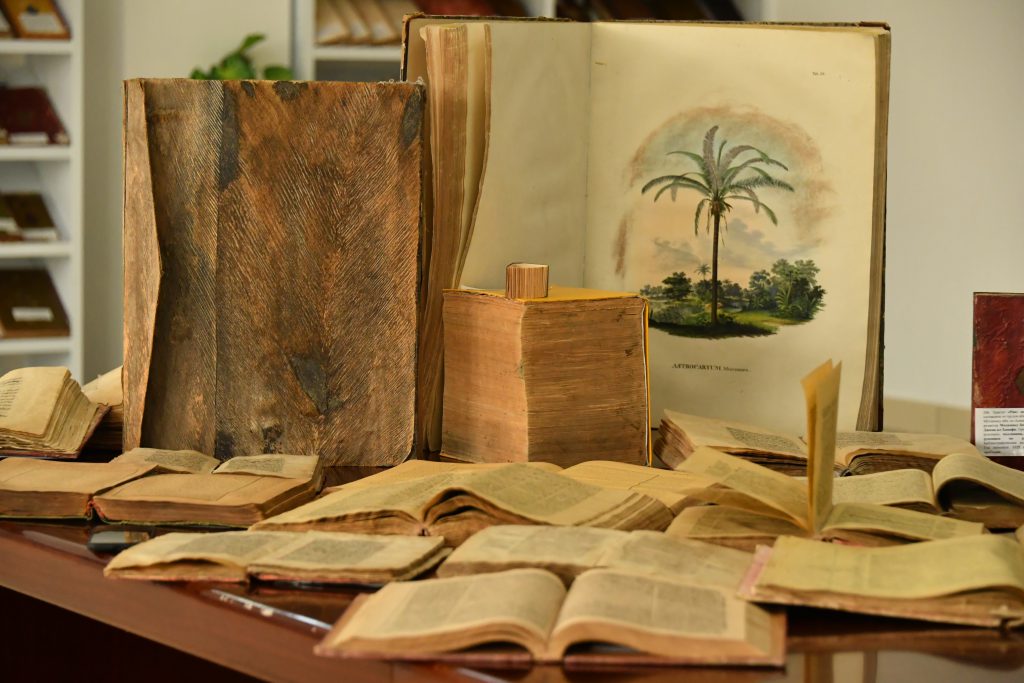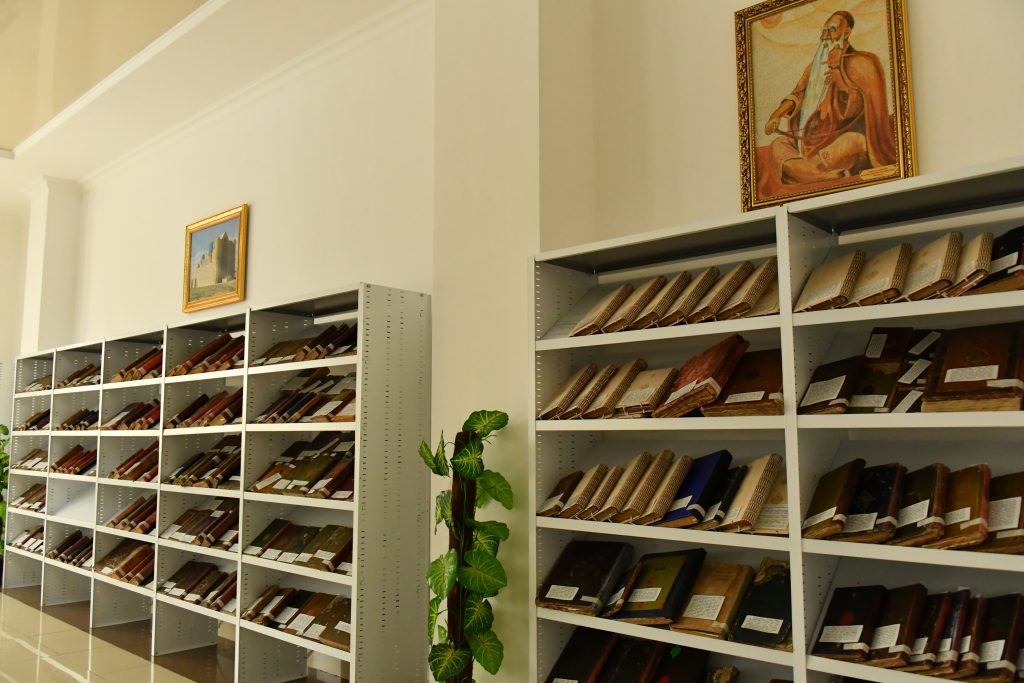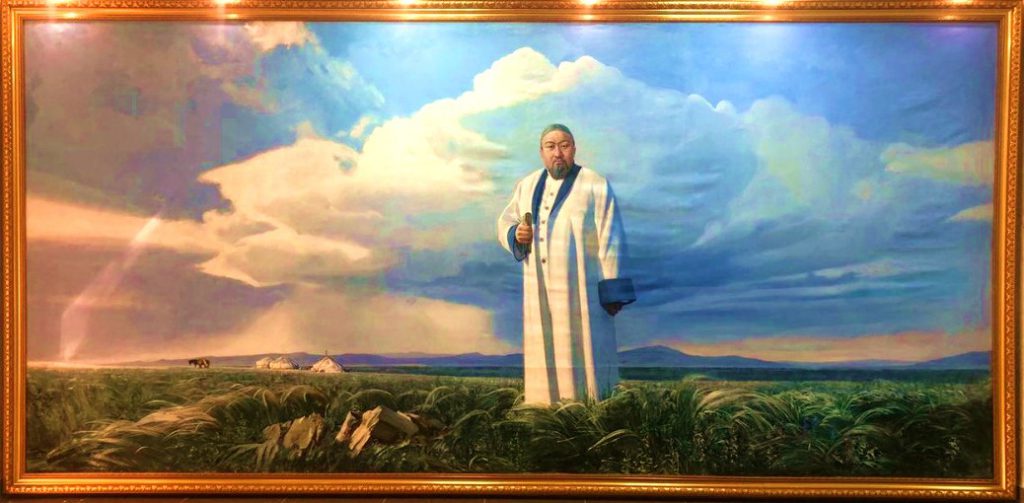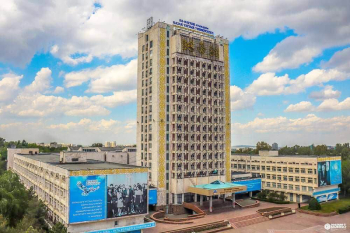Digital library
In the Al-Farabi Library on November 14, 2014, an electronic library hall was opened (Fig. 13). This is a large and comfortable hall, which has all the conditions for a comfortable work of users. Currently, the electronic form allows you to store information most reliably and compactly, distribute it much more quickly and widely, and also provides opportunities for transformation into other forms. The transition from the traditional form of storage to electronic storage is becoming widespread. The al-Farabi library has created an electronic database and a full-text database of resources of its own generation.The database of its own generation of the Al-Farabi Library includes full texts of textbooks in all branches of knowledge, abstracts of dissertations, works of al-Farabi and works of Abai and world textbooks in the Kazakh language within the framework of the project “New humanitarian knowledge. 100 new textbooks in the Kazakh language ".Currently, the Database of its own generation is integrated into the Univer system. There is also a subscription to 12 subscription electronic databases: Elsevier [elsevier.com], Scopus [scopus.com], Sciencedirect [sciencedirect.com], Springer [link.springer.com], Oxford University Press (OUP) [oxfordscholarship.com], Платформа Wiley Online Library, Web of Science [webofknowledge.com], Polpred.com[ http://www.polpred.com],. «IPRbooks [iprbookshop.ru], ЭБС «Лань» [e.lanbook.com], Юрайт [urait.ru], «Эпиграф» [res.epigraph.kz].

The electronic library is functionally divided into the following areas:
- The area of work with the Internet, designed to work with the electronic portal, library catalog, corporate governance network of the university, Internet resources – digital libraries of the world, online libraries of Kazakhstan and the CIS countries, libraries of partner universities.
- The area of work with the fund of search sources gives an opportunity to access electronic editions of world publishing houses.
- The zone for working with multimedia information (video, audio, graphics) performs the functions of viewing new resources, processing and developing; makes it possible to enter the sites of TV channels.
- The satellite TV zone is intended for personal and group viewing of programs of video materials and digital televisions, the possibility of registering for television programs shown online, the offer of IDTV services by Kazakhtelecom.
- The area for working with graphic programs is the ability to work with graphic editors, building maps (in the specialty “Cartography”), mathematical modeling, execution of projects in computer 3D graphics.
- The linguaphone zone is intended for independent mastering of foreign languages by students.
- The laptop zone is an opportunity to work with personal data on your own.
Hall of the first President
The Hall of the First President of Kazakhstan, opened for the 25th anniversary of the country's independence, is a kind of educational center, whose tasks are to create, constantly replenish and store an information array on the history of the formation and strengthening of the independent state of Kazakhstan (Fig. 9). Here are placed 326 copies of 252 titles; archival electronic copies of documents from the personal archive of the President of the country. In the fund, you can also familiarize yourself with congratulatory letters and addresses of the President to the staff of KazNU, of which he is an honorary professor. Of particular interest to students and scientists are the lectures of the Head of State delivered both at the Kazakh National University and in other universities of the world.The main sources of the open fund of the First President's Hall are the historical works of the President over the years of independence. Presented are photographs of family, student, student times, work path and socio-political activities; copies of archival documents. The First President's Hall is a modern hall equipped with an interactive LED panel, an electronic flip chart, and a multimedia tribune.


Hall of rare and valuable publication
The fund of rare books and manuscripts is a specialized section of the main fund and belongs to the system of working funds. To date, the frequency of accumulation of rare books and manuscripts dates back to the 17th – early 21st centuries in various branches of science. The Rare Books Fund is a part of the main fund, which includes rare or especially valuable documents distinguished by outstanding historical, scientific, artistic, aesthetic and printing qualities.
In 1984, the Library was allocated a room for storing rare books. A sector of rare books and manuscripts was organized, work with the fund began: the selection of appropriate publications from the general funds of the library and donated literature from private collections and book collections of university professors. Among the donors were various institutions and organizations – the Ministry of Education, scientific societies, universities in Moscow, Leningrad, Kazan, purchases in second-hand bookshops, but much more books came from private individuals.
The collection of rare books and manuscripts includes:
- handwritten books (17th – 19th centuries); rare and valuable books (XIX – XXI centuries);
- books in the ancient Slavic language;
- rare foreign editions (XVII-XIX centuries);
- miniature books (XІX – XX centuries);
- section Kazakhstani;
- publications from personal libraries;
- modern editions (XXI century).
It should be noted that our unique collection of rarities is one of the largest among university libraries in Kazakhstan and is in demand in all research areas of the university. Among them are publications of historical, cultural and scientific value, as well as printed books published in Arabic, Latin and Cyrillic graphics.In the fund you can see collections of manuscripts, Western European editions, old printed editions, Old Slavonic printed editions of the 17th-19th centuries. In particular, the monuments of book culture are the manuscripts "Code of Tsar Alexei Mikhailovich", XVIII century., "History of Roman law", early. XX century, photocopies of the manuscripts "Jami at-tavarih" K. Jalairi, 1600, "The manuscript of A. Pushkin: album of 1833-1835", 1939 (Fig. 18)



The room also contains reference publications: encyclopedic dictionaries, masterpieces of the world classics of the 18th-19th centuries, incl. copies of the largest pre-revolutionary Russian universal encyclopedias: "Encyclopedic Dictionary" by the publishers F.A. Brockhaus and I.A. Efron, "Pomegranate Encyclopedic Dictionary." The Brockhaus and Efron Encyclopedia is the largest pre-revolutionary universal encyclopedia of 86 volumes. The publication lasted seventeen years. Covers a wide variety of areas of knowledge: philosophy, history, geography, natural sciences, jurisprudence, literary criticism and fiction.
Hall of Abay
Abai's creative heritage is a spiritual wealth that has absorbed all the wisdom of the Kazakh people accumulated over the centuries.
Abai, as a poet, thinker, educator, translator, composer, left an indelible mark on the history of our country. Abai's creativity should be in the minds of every citizen of the country. His works should become a reference point in the formation of literary taste, the formation of a spiritually developed personality of the young generation of Kazakhstanis. To this end, the Abay Hall was opened in the Al-Farabi Library of the Al-Farabi Kazakh National University in 2019
The Abay Hall in the Al-Farabi Library is a platform for the exchange of views between young people and university scientists on current topics in Abai's work, for which a large projector screen and an interactive tribune are installed here. In the hall of Abai there are paintings depicting the life of Abai. The central of them is a large painting "Abai" (Fig. 19), on which, depicting the poet against the background of the steppe and mountains, the artist showed the greatness of Abai, his connection with his native land, and the white dress emphasizes the purity of the poet's soul and thoughts. The author of the picture is a famous artist, a member of the Union of Artists of Kazakhstan V.Ya. Krymov.

Fig.19 “Abay” Hood. V.Ya. Krymov
Abai, who loved his people with all his heart, did a lot for their enlightenment, introduction to world literature, masterfully translating the poems of A.S. Pushkin, M. Yu. Lermontov, fables by I.A. Krylov. Therefore, the iconic painting displayed in the Abay hall is “Abai and E.P. Michaelis in the Library “(Fig. 20), by the artist Ya.M. Antonyuk (Fig. 20),. The poet was personally acquainted with representatives of the Russian intelligentsia exiled to Semipalatinsk.



In the next picture, Ya.M. Antonyuk "Abai with sons" (Fig. 21), the poet is depicted together with his eldest son Akylbay (on the right) and with the youngest - Turagul (on the left).
Painting by artist G.G. Konkaraeva "Young Abai" (Fig. 22), As you know, Abai began to write his first poems at the age of ten and from his youth was distinguished by eloquence, read a lot, was engaged in self-education.


The painting "Abai among the berkutchi" (Fig. 23) by artist N. Zhoshybayev shows that Abai has always been at the center of the life of the common people, knew firsthand about Kazakh national crafts.
Another picture of the work of N. Zhoshybayev "Abai's homeland - Kaskabulak" (Fig. 24). It turns out that Abai was not born in the Zhidebai tract, as many believe, but a little closer to the city, in an area called Kaskabulak. Kaskabulak was the camp of the aul of the volost ruler of biy Kunanbai Uskenbaev, who in the summer of 1845 gave birth to a boy named Ibrahim, who became known to the world as Abai.
Abai is known not only for his works, which have become classics, but also as the founder of the poetry school, which had a great influence on his disciples and followers in his time and continues to influence the work of modern poets. The room contains a portrait of his student Shakarim Kudaiberdiev, made by the artist V.Ya. Krymov.
Also in the hall are portraits of famous researchers of his work - writers, scientists and public figures (A. Baitursynov, M. Auezov). The epic novel "Abai's Way" is the pinnacle of creativity of the writer, publicist, scientist M. Auezov.
Akhmet Baitursynov called Abai Kunanbayev the first poet of the Kazakhs: "Neither in the early, nor in the later period of the history of Kazakhs is the name of a poet known to surpass him in greatness of spirit." The hall contains stands with quotes from the poet's works, reflecting his thoughts, views, aspirations. For example, the quote "Adamzattyk burin suy bauyrym dep" expresses the poet's large open heart.
Center for digitalization
Digitalization Center, which is engaged in the translation of information resources from paper media into digital format, the creation of an electronic library of the University (http://elibrary.kaznu.kz/ru).
The Kirtas KabisIII autoscanner with a unique technology in order to replenish the stock of the electronic library, taking into account the demand of readers, at a high quality and quickly transforms textbooks from a traditional to an electronic form (Fig. 25). Under the supervision of the operator, without causing any damage to the original, using a vacuum technology with over one hundred Sure Turn products in 1 hour, carefully turning over, photographs 3000 pages.
The Bookskan Editor program in the device reads 177 languages, formats and corrects. Digital web pages are saved in JPEG, TIFF, Word and PDF formats. This unit was launched in the Library. al-Farabi was commissioned in 2012 and has been working for the benefit of the Library ever since. The Digitalization Center quickly and efficiently digitizes documents and carries out online orders of users.
The al-Farabi library, through the formation of an electronic library, in accordance with the development strategy, provides services, ensuring the replenishment of the fund, storage, use of full-fledged and high-quality sources of information in the training system

Ban Ki-moon Institute for Sustainable Development. KazNU them. Al-Farabi became one of the ten global hubs of the UN Academic Impact Program and made a significant contribution to the implementation of the Sustainable Development Goals at many international platforms, including the G-Global platform.
Office of the United Nations Academic Impact Global Hub. The global hub of KazNU became the first and only university in the CIS to be awarded such a high position at the international level. Having become one of the 10 global UN hubs, KazNU coordinates and actively involves the world academic community in the implementation of 17 goals of sustainable human development aimed at preserving the planet's resources, ensuring the availability of high-quality education and well-being, developing innovations, preserving ecosystems, etc.
Book Corner Hall of the World
Today, the university has formed invaluable traditions of international cohesion, expanded global partnerships, developed academic mobility of the teaching staff and students, the number of scientific projects with foreign participation is constantly growing, in which favorable conditions have been created for foreign students of a higher educational institution. Each year, strengthening its leadership role in the academic field, our university turns into a venue for organizing events of regional and global importance.
n the basis of these projects, under the leadership of the library of the Al-Farabi Kazakh National University, the Book Corner hall of the countries of the world was opened. Book corner of the countries of the world, introducing the readership to the history and literature of different peoples, representatives who study at the university and cooperate with KazNU. Today in this hall are open corners dedicated to the culture and literature of Japan, Qatar, Afghanistan and other countries. The fund of this hall consists of books on history, literature, culture, art, law, economics. There are also magazines, reference books, dictionaries, albums on local history, donated by the embassies of China, Turkey, India, Romania, Egypt, etc.

